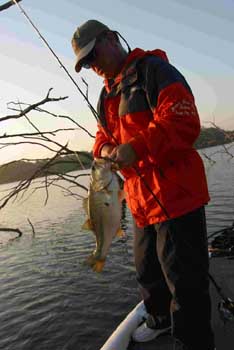Bass Are a Blast
Please note the publication date of this article. Statistics and seasonal information were accurate at the time of publication. Check links provided for the most current information.
By Larry D. Hodge
Published in Houston Business Journal, Spring 2005
 Rx
for stress: Trade the boardroom for a bass boat.
Rx
for stress: Trade the boardroom for a bass boat.
No matter how you fish—with live bait under a bobber, ripping crankbaits along the edge of boat docks, teasing Texas-rigged plastic lizards through submerged brush, or walking topwater baits over grass beds—few things are more relaxing than a day on the water. And the pleasures are multiplied when you share the experience with a child.
According to a survey conducted by the U.S. Fish & Wildlife Service in 2001, some 1.68 million Texans age 16 and older fish in Texas lakes and streams. Most of those—1.52 million—fish in ponds and reservoirs. Those anglers generate $690 million in wages and salaries annually and pay $79 million in sales tax.
Texas is particularly rich in inland waters. The drought of the 1950s brought home to Texans the fact that a growing state had to grow its supply of fresh water, and a burst of dam-building followed. Today a state whose popular image smacks more of deserts and plains than of lakes and streams enjoys more surface acres of water than any other state except Minnesota.
The proliferation of lakes built mainly for water supply and flood control sparked a revolution in outdoor recreation. Fishing became the outdoor activity of choice (anglers in Texas outnumber hunters two to one), and bass fishing took off as Texas Parks and Wildlife Department (TPWD) stocked new lakes with both native largemouth bass and bigger-growing Florida largemouths, as well as a variety of other species. But appropriately for a state known for its lack of shyness when touting its assets, largemouth bass are king.
Nowhere in Texas are more big largemouth bass caught than in Lake Fork, located in northeast Texas about a five-hour drive north of Houston. From March 2003 through March 2005, Lake Fork anglers reported catching 3,884 bass weighing 7 pounds or more. Of those, 592 tipped the scales at 10 pounds or better.
But only 27 fish broke the 13-pound barrier that admits largemouths into the Budweiser ShareLunker program. This program spawns big females donated by anglers and returns the fry to the lake. The idea is to produce bass that grow bigger, quicker. ShareLunkers are accepted from any body of water in Texas, public or private, but Lake Fork has contributed some 60 percent of the total.
Richard McCarty, who has donated three ShareLunkers, shared some tips on how to catch a bragging-size bass. When bass are in shallow water, as they are during the spring spawning season, McCarty sight fishes for largemouths the way a fly fisher does for trout in clear mountain streams. Once he spots a female on her bed, he tries to entice her to take a bait.
“In early morning I throw a topwater bait,” he says. “I keep a rod rigged with a plastic lizard close at hand in case a big fish blows up on the topwater. Lots of times a bass will slam a moving bait out of anger and show itself, but it’s not aggressive enough to eat it. I go right back in there with a lizard, and 30 to 40 percent of the time, I’ll catch that fish.”
What’s McCarty’s secret for catching big bass? “The difference between guys who catch big bass and guys who don’t is in their proficiencies with individual lures and how many effective casts they make in a day as opposed to just flailing the water,” McCarty says. “The guys who make the most proficient casts in a day will catch more fish. I’ve caught three ShareLunkers, and I attribute a lot of that to time spent on the water and having a lure in the water a lot.”
Bass fishing and artificial lures go together like fish and water, and some people feel it’s unethical to fish for bass using live bait, since bass may swallow bait and hook too deeply to be removed. Kathy Magers, who has fished professionally and hosted her own televised fishing show, sees two sides to the debate. “I like to use lures, and I encourage children to use lures, but an artificial bait is only as good as the action it has, and children don’t have the skill it takes to use a lure the way it should be worked,” says Magers, who specializes in teaching children to fish. “When fish won’t bite on lures, I suggest using live bait under a bobber and fishing for any species. You may catch bass, and you may not. To minimize deep hooking that can harm fish, set the hook quickly. If you can’t get the hook out easily, cut the line and leave the hook in place. That holds true for live bait or artificials.”
The rewards of family fishing go far beyond happy memories and food for the table. “When you fish with a child, you bond with that child, and no one can take that away from you,” Magers says. “I can’t talk to my grandkids on the phone, but put them in a boat with me, and we communicate. The thing I like best is when they call and say, ‘Grammie, when are we going fishing again?’ That means either they want to be with me, or they just want a fishing guide, but I know for that one day I rank above dolls and video games and all those things—and I love it.”
© Copyright Texas Parks and Wildlife Department. No part of this work may be copied, reproduced, or translated in any form or medium without the prior written consent of Texas Parks Wildlife Department except where specifically noted. If you want to use these articles, see Site Policies.